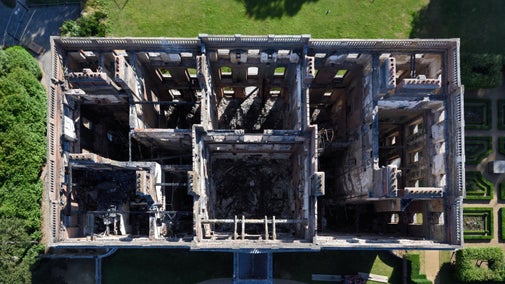
Clandon Park's collections
Explore the objects and works of art we care for at Clandon Park on the National Trust Collections website.

Before the devastating fire in 2015, Clandon Park held a rich collection of the types of object you would expect to find in a country house. Learn how, although the fire destroyed much of this collection, determined rescue efforts meant that over 500 objects were saved that fateful night, including ceramics, textiles and paper.
Objects rescued after fire include paintings, furniture, sculpture, silverware and ceramics, as well as a significant group of New Zealand and Pasifika related material. They had been mostly collected by members of the Onslow family over the years but included a large, additional collection given to the National Trust by the collector Hannah Gubbay in 1969.
Collection objects are physical evidence of the purpose of the house and of the lives lived at Clandon. These survivals will allow the stories of the house to continue being told, along with those of the people who have lived, worked and visited here over the centuries.
From books and accounts written by members of the family and silverware and ceramics made by master craftsmen, to personal trinkets kept as mementos, the range of objects that survived is testament both to the preparedness of staff and the efforts of Surrey Fire and Rescue.
Almost 30 paintings were saved – including works by great artists such as William Hogarth, Godfrey Kneller and Francis Barlow – some of which had to be hastily cut from their frames to be taken to safety.
The curtains from the State Bed and four accompanying chairs, dating from around 1710, were another important survival, carried out of the house by firemen from the State Bedroom.
Objects that were lost in the fire – the ‘ghost’ collection – are still an important part of Clandon’s history and aren’t forgotten. Photographs and documentation mean the team can continue to think about, research, learn from, share, and tell the story of these objects and the wider significance they hold in the story of Clandon.
In addition to the objects that were saved on the night, archaeologists carefully looked through the debris after the fire and a further 500 objects were salvaged. Amongst these are some extraordinary stories of survival.
The Onslow family provided three Speakers for the House of Commons through the centuries, each presiding over House debates and maintaining order. These men were celebrated in the Speakers' Parlour. Furthest from the fire, this room survived almost intact. Decisive action after the fire to support the room’s precious plasterwork ceiling means we will now be able to conserve and restore it using traditional heritage skills.
Objects taken to safety included personal items belonging to Speaker Arthur Onslow, including his silver christening cup and silk stocking. Remarkably, the carved mahogany side tables and the large dining table and its suite of chairs were passed out of the window. Smaller items such as porcelain and delicate gilt-etched glassware were also saved.
All the paintings hanging in the room, including the huge portraits of Arthur Onslow and Richard Onslow, were rescued on the day of the fire, although the large gilded frames were too heavy and awkward to remove.
It is remarkable that the decorative plaster ceiling by the artist Guiseppe Artari survived, despite the fire and water. It was carefully propped in the days following the fire and this undoubtedly saved it from total collapse. The original chimneypiece, designed by Giacomo Leoni, also survived.

Apart from tiny fragments from other rooms, the historic wallpaper in the Speakers’ Parlour is the only paper that survived. Closer inspection found five layers of paper – three that were known about and two that we had no record of – with the earliest dating to the late 18th century.
The two oldest layers of wallpaper here were not sold as long rolls as the later additions were. These were manufactured in small sheets (equivalent to about A3 size), which were pasted on to a stretched hessian scrim backing. These sheets of high-quality paper made with finely chopped rags were painted to give a flat, uniform appearance, in this case in a beautiful light grey-mauve.

Explore the objects and works of art we care for at Clandon Park on the National Trust Collections website.
Curator Sophie Chessum witnessed the fire at Clandon Park first-hand. Read her account of the night of 29 April 2015.

Clandon Park's history spans more than three centuries, from its origins as a grand Georgian home to its time as a First World War military hospital and subsequent restoration in the 1960s.

Discover the history of Hinemihi. Follow her journey from construction in New Zealand to the grounds of a stately home in Surrey.

The Onslow family first moved into Clandon Park in 1641 and since then there have been record-breaking politicians, First World War workers and pioneering women.

See the breadth of our collection of works of art, furniture and more: we care for around a million objects at over 200 historic places, there’s a surprise discovery around every corner.

Discover the stories behind some of the greatest artworks and artefacts looked after by the National Trust, as told in a dedicated book, 125 Treasures from the Collections of the National Trust.

The art and heritage collections we care for rival the world’s greatest museums. Learn more about the collection of paintings, decorative art, costume, books, household and other objects at historic places.
